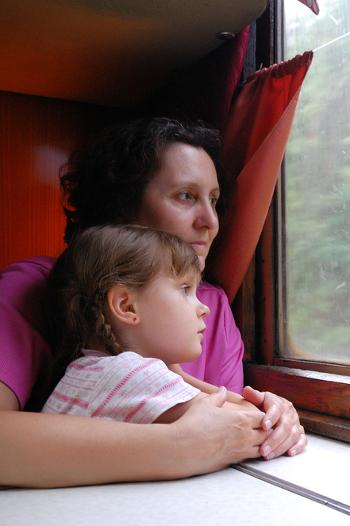Travelling with children
Duration/age

There are many different ways you can travel to a place. You could go by bus, train or tram. Next time you are travelling by public transport with your child take some time to talk about the different things that you notice around you.
Talk with your child about what you see inside the vehicle compared to outside. Inside there will be lots of different people to notice compared to outside. Point out to your child the different shapes and sizes of the people or what they are wearing.
Can you see the short man with the blue hat?
When you both look out the window what do you notice? Can you see houses with letterboxes or lots of cars? Talk about the different colours of the cars and how many you can see.
Let’s count the blue cars and the red trucks.
Explore what else you can see through the window. Are there birds or animals? What can you see in the sky?
As you travel along make up silly songs about what you see. You could also sing your favourite songs together.
Materials you will need
- Your voice
Alternative tools
- Tablet / smart phone
- Camera
- Picture books
- Lotto card
Skills this activity improves
Why does this matter?
Children have a natural sense of wonder about the world around them. Talking about the things you notice as you travel helps children to make sense of what they observe. It also helps them to organise the information into meaningful patterns.
Talking together about what you have noticed on your travels helps your child to ask questions. As they notice objects they can group them and compare the differences. As they talk about what they notice they are developing language to describe their thinking and observations.
When children begin to describe their thinking they have started to hypothesise. When they hypothesise they are beginning to connect what they see to past experiences and to use this information to make decisions, reflecting on why things have happened.
What does this lead to?
Some children are naturally curious and creative, taking risks in their learning. Children who are naturally curious and creative often notice and wonder about what they see around them. They will ask questions and create their own answers. These children have a disposition to be creative and curious.
Talking about and exploring the natural and everyday environment with your child will help them to develop the skills to notice, take risks and ask questions. Even if your child does not have a natural disposition to be creative and curious, by exploring and posing questions you are helping your child to experiment with different ways of thinking.
Language to use
- Seat, position, transport, entrance, exit, window
- Bus, train, tram, car, plane, taxi
- Number, object, people, plants, animals
- Colour, shape, size, position
Questions to use
- How many people are on the bus?
- Are there more men than women on the bus?
- What can you see out the window?
Useful tips
- If you are travelling by car you can play music CDs or story tapes.
- Create a travelling box of special things that can be played with on long trips.
- You might also like to take a look at the activities We went walking, On the tram and Out and about on North Terrace.
- Remember to talk to your child in your home language.
Variation by age
Birth to two year olds
- Sing songs together.
- Read books together.
- Talk about the people getting on and off the bus.
- Point out the different things you see out the window.
- Clap how long it takes for people to get on the bus.
- Make a 'fiddly' toy to keep your little one busy. Tie a piece of string onto a yoghurt lid with holes punched in it. Try and weave the string in and out of the holes
Three to five year olds
- Play I-spy.
- Make lotto cards of different clothing to take with you on the bus. Mark off the different ones you see.
- Sing songs together.
- Read books together.
- Talk about the people getting on and off the bus. Point out the different things you see out the window.
- Time how long the trip takes.
- How many different shapes can you spot?


